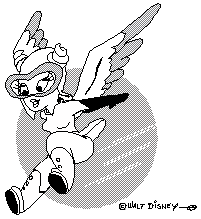VALOR |
||
| The WASPs of World
War II Early in World War II, Army Air Forces was critically short of pilots, but a partial solution was immediately at hand. T HEY made a notable contribution to America's role in World War II and to the future of military aviation, yet they were not officially a part of our wartime air arm. They were the Women's Airforce Service Pilots (WASPs), and they freed hundreds of male pilots for combat duty. The WASPs sprang from two roots that merged in August 1943. First was the Women's Auxiliary Ferrying Squadron, approved in September 1942 and headed by Nancy Love, an experienced pilot and civilian member of the Air Transport Command Ferrying Division. Applicants to the squadron were required to have 500 hours flying time and a 200-horsepower rating. Second was the Women's Flying Training Detachment (WFTD), created in November 1942 and headed by Jacqueline Cochran. Located at Avenger Field, Tex., the WFTD trained women with varying pilot experience, eventually down to a minimum of thirty-five hours, to fly "the Army way." Over time, the curriculum went through many changes to become a virtual duplicate of the Aviation Cadet program. Both groups were under civil service, but Cochran had in mind militarization with eventual commissions for her graduates, who would serve in many domestic flying roles, including ferrying aircraft. Against the wishes of both women, WASPs
initially were Now that the barriers were down, the WASPs began flying every first-line fighter, bomber, trainer, and transport in USAAF's inventory. By late 1944, half of Ferrying Division's fighter pilots were WASPs, and they made three-quarters of all domestic fighter deliveries with a lower accident rate than male pilots had. |
Many WASPs became test
pilots at overhaul and repair depots, another dicey and anonymous job. Others were
assigned to Training Command as flying cadet navigators, bombardiers, and instrument
instructors. About 100 WASPs were sent directly from AT-6s to B-26 Marauder transition. At that time, the B-26 was considered by some to be the most difficult and dangerous USAAF aircraft. The WASPs did as well as the men at flying the bomber and much better in ground school. After completing the course, many WASPs flew B-26s on tow-target missions to train aerial gunners. A few visited B-26 transition bases as a confidence-builder for male pilots who did not regard the Marauder as user-friendly. In its early days, the B-29 also had a bad reputation. Lt. Col. Paul W. Tibbets, of Enola Gay fame, checked out two WASPs, Dora Dougherty and Dorothea Johnson, in the B-29 and sent them to a heavy bomber base to reassure nervous B-29 students. The Air Staff, when it learned of Colonel Tibbets's ploy, directed that WASPs were not to fly the B-29 again. Perhaps the most unusual WASP flying experience was that of twenty-nine-year-old Ann Baumgartner, who was sent to Wright Field, not as a pilot but as a consultant on new flying equipment. She soon persuaded the brass to let her fly P-51s, P-47 Thunderbolts, a Japanese Zero, and a Bf-109. Ms. Baumgartner also got permission to fly the experimental Bell YP-59 jet fighter, becoming the only American female jet pilot, a distinction she held for almost a decade. In December 1944, as the need for combat pilots declined, the WASPs were inactivated. In its twenty-eight-month life, the WASP organization drew 25,000 applicants; 1,830 were accepted, 1,074 won their wings, and thirty-eight lost their lives taking part in a wide range of domestic flying duties. They ferried more than 12,000 aircraft of seventy-eight types, served without military benefits, and were paid two-thirds as much as the male civilian ferry pilots they had replaced. The WASPs frequently endured discrimination, yet many offered to continue ferrying aircraft for a dollar a year. In 1949, the newly independent United States Air Force offered commissions to former WASPs. The 121 who accepted were assigned to administrative and support duties and did not fly military aircraft again. It was not until 1977 that Congress passed a bill, introduced by Sen. Barry Goldwater (R-Ariz.), that gave the WASPs honorable discharges and declared them veterans. Their accomplishments during the war reflected courage and determination, paving the way for women to be admitted to military flying training .again, but it would be more than thirty years before the road was completed. |
|
Scanned from AIR FORCE Magazine / November 1995 p. 37
 restricted to daylight flights in liaison
aircraft and primary trainers. Nancy Love broke that barrier by wangling permission to
check out in B-17s and P-51 Mustangs. Cochran did her part by convincing Gen. Henry H.
"Hap" Arnold, Commanding General of US Army Air Forces, that her graduates could
tow targets as well as ferry aircraft. At Camp Davis, N. C., an antiaircraft training
base, the WASPs flew tired, badly maintained A-24 and A-25 dive bombers. Two women lost
their lives because of engine failure, and several were hit by ground fire, but others
volunteered for that risky business, which few male pilots wanted.
restricted to daylight flights in liaison
aircraft and primary trainers. Nancy Love broke that barrier by wangling permission to
check out in B-17s and P-51 Mustangs. Cochran did her part by convincing Gen. Henry H.
"Hap" Arnold, Commanding General of US Army Air Forces, that her graduates could
tow targets as well as ferry aircraft. At Camp Davis, N. C., an antiaircraft training
base, the WASPs flew tired, badly maintained A-24 and A-25 dive bombers. Two women lost
their lives because of engine failure, and several were hit by ground fire, but others
volunteered for that risky business, which few male pilots wanted.